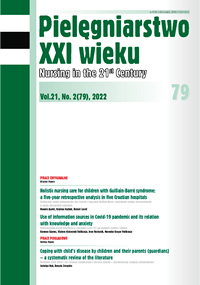Use of information sources in Covid-19 pandemic and its relation with knowledge and anxiety
DOI:
https://doi.org/10.2478/pielxxiw-2022-0013Keywords:
COVID-19 pandemic, anxiety, sources, knowledge, communicationAbstract
USE OF INFORMATION SOURCES IN COVID-19 PANDEMIC AND ITS RELATION WITH KNOWLEDGE AND ANXIETY
Introduction. Production of useful information during a pandemic is a key element of outbreak control strategies.
Aim. As no study has yet examined what information sources were used in the COVID-19 pandemic and how the use of information sources is related to knowledge and anxiety, this research tries to fill the research gap. Material and methods. We conducted an explorative study among 7,764 Slovenian population to assess the use of information sources, knowledge, and anxiety, and determine the relationship between different information sources and knowledge and anxiety in lay public in Slovenia during the pandemic of COVID-19.
Results. A combination of unregulated internet-based information sources and regulated ones were frequently used information sources. The Internet as the main source was more used by younger and more educated individuals. Traditional mass media and religious organizations were more frequently used by older participants, while friends and/or relatives and/or colleagues and natural therapist by younger participants. Results also show that greater anxiety is associated with the greater need for information.
Conclusion. Informing people should not primarily be based on the traditional interpersonal communication between a doctor and patients, other face-to-face communication or the use of printed information, but rather on regulated and unregulated websites, social media, and TV.
References
1. Selinger CP, Carbery I, Warren V, et al. The relationship between different information sources and disease-related patient knowledge and anxiety in patients with inflammatory bowel disease. Aliment. Pharmacol. Ther. 2017; 45(1): 63-74.
2. Niederdeppe J, Hornik RC, Kelly BJ, et al. Examining the dimensions of cancer-related information seeking and scanning behavior. J. Health Commun. 2007; 22(2): 153¬167.
3. Abramowitz JS, Braddock AE. Psychological treatment of health anxiety and hypochondriasis: A biopsychosocial approach. Göttingen, Germany: Hogrefe & Huber; 2008.
4. Ferguson E. A taxometric analysis of health anxiety. Psychol. Med. 2009; 39(2): 277- 285.
5. Taylor S. The Psychology of Pandemics: Preparing for the Next Global Outbreak of Infectious Disease. Newcastle, UK: Cambridge Scholar Publishing;2019.
6. King CL, Chow MYK, Wiley KE, et al. Much ado about flu. Influenza Other Respir Viruses. 2018; 12(4): 514-521.
7. Gorney C. Numbers versus pictures: did network television sensationalize Chernobyl coverage? Journalism Quarterly 1992; 69(4): 455-465.
8. Young ME, Norman GR, Humphreys KR. Medicine in the popular press. PLoS One 2008; 3(10): e3552. https://doi.org/10.1371/journal.pone0.0013552.
9. Walter D, Böhmer MM, Reiter S, et al. Risk perception and information-seeking behaviour during the 2009/10 influenza A(H1N1)pdm09 pandemic in Germany. Euro Surveill. 2012; 17(13): http://www.eurosurveillance.org/ViewArticle. aspx?ArticleId=201312012.
10. Baumgartner SE, Hartmann T. The role of health anxiety in online health information search. Cyberpsychol. Behav. Soc. Netw. 2011; 14(11): 613-618.
11. Worldometer. Available from: https://www.worldometers.info/coronavirus/ (cited 20 July 2020).
12. Guo Y-R, Cao Q-D, Hong Z-S, et al. The origin, transmission and clinical therapies on coronavirus disease 2019 (COVID-19) outbreak – an update on the status. Mil. Med. Res. 2020; 7(1): 1-11.
13. WHO (2020) Alert and response operations Diseases Biorisk reduction Disease outbreak news First data on stability and resistance of SARS coronavirus compiled by members of WHO laboratory network. Available from: https://www.who.int/csr/ sars/survival_2003_05_04/en/ (cited 14 March 2020).
14. Lu S. An epidemic of fear. American psychological Association. Available from: https://www.apa.org/monitor/2015/03/fear (cited 18 March 2020).
15. Klucevsek KM. The intersection of information and Science Literacy. Communications and Information Literacy. 2017; 11(2): 354-365.
16. Nowrouzi B, Gohar B, Smith C, et al. An Examination of Health, Medical and Nutritional Information on the Internet. J. Commun. Healthc. 2015; 6(1): 30-38.
17. Pierri F, Ceri S. False news on social media: a data-driven survey. Available from: https://www.researchgate.net/publication/331246175_False_News_On_Social_ Media_A_Data-Driven Survey (cited 21 July 2020).
18. Wang C, Pan R, Wan X, et al. Immediate psychological responses and associated factors during the initial stage of the 2019 coronavirus disease (COVID-19) epidemic among the general population in China. J. Environ. Res. Public Health. 2020; 17: 1-25.
Downloads
Published
Issue
Section
License
Copyright (c) 2022 Authors

This work is licensed under a Creative Commons Attribution 4.0 International License.




